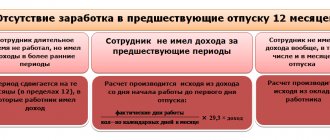How to divide the vacation period
According to the Labor Code of the Russian Federation, annual paid leave can be divided into parts by agreement between the employee and the employer (Article 125). But only on condition that at least one of the parts lasts 14 days. The rest of the period is divided into any number of parts.
For example, an employee has one part of vacation for at least 14 days under Article TC 125. After some time, he took out two more vacation periods of a week each. The Labor Code does not prohibit taking even 1 paid day off, if so included in the vacation schedule. However, in practice, even if an employee has taken 14 days of vacation according to the Labor Code, employers are extremely reluctant to divide the vacation into periods of 1 to 5 days, since this involves paperwork. In addition, when drawing up a schedule, the employer assesses the production need for a particular employee in a specific period of time, and frequent and short breaks in work negatively affect the work of the company. In many organizations, during the absence of one or another employee, it is necessary to appoint a replacement, which complicates the procedure for registering leave. In particular, such difficulties are encountered in organizations whose functioning occurs only in the presence of an established quorum. For example, various expert commissions.
DURATION OF ANNUAL PAID LEAVES
The minimum duration of the annual basic paid leave provided to employees is 28 calendar days (Article 115 of the Labor Code of the Russian Federation). Certain categories of employees, in accordance with the Labor Code of the Russian Federation and other federal laws, are granted the so-called extended basic leave, the duration of which is more than 28 calendar days.
Vacation may be increased if additional paid vacations are added to it. The list of employees who are granted additional paid leave is established by Art. 116 Labor Code of the Russian Federation.
For example, on the basis of Order of the Ministry of Emergency Situations of Russia dated June 3, 2011 No. 285 (as amended on October 15, 2012), employees of the federal fire service of the State Fire Service are provided with additional annual paid leave for length of service.
Also, the employer, taking into account its production and financial capabilities, can independently establish additional leaves for its employees, unless otherwise provided by the Labor Code of the Russian Federation and other federal laws. However, such a possibility must be provided for in a collective agreement or in a local regulatory act, which are adopted taking into account the opinion of the elected body of the primary trade union organization.
Note that when calculating the duration of annual paid vacations, non-working holidays falling during the vacation period are not included in the number of calendar days of vacation (Articles 112, 120 of the Labor Code of the Russian Federation). Regular weekends are included in the duration of vacation, since it is calculated not in working days, but in calendar days (Article 115 of the Labor Code of the Russian Federation).
How to apply
The Labor Code of the Russian Federation stipulates whether annual paid leave can be divided into four equal parts - yes, subject to the 14-day rule. No later than two weeks before the start of the new year, the company draws up a vacation schedule. The employer approves this document taking into account the opinion of the staff and the production needs of the enterprise. It is not necessary to familiarize staff with this document, but some enterprises prefer to do this with a signature in order to avoid misunderstandings.
In fact, how an employee can manage his vacation is his personal business, but the division of vacation should be agreed upon with the employer and documented. Often employees write a corresponding statement addressed to the manager.
And although the Labor Code of the Russian Federation approves whether the division of vacation into parts is allowed (yes, it is allowed), the parties need to agree on everything in advance. At least two weeks before the start of the vacation, the employer sends the employee a corresponding notice, where the employee puts a mark on familiarization.
ConsultantPlus experts examined the features of dividing annual leave into parts. Use these instructions for free.
If an employee wants to be given an unscheduled break, he fills out a corresponding application. If there are no problems in the organization, the manager will meet halfway and sign the application. It doesn’t matter how many parts vacation can be divided into according to the Labor Code in 2021, all rest periods must be reflected in the working time sheet. For this, the code “OT” or “09” is used.
Providing leave
The employee must be granted leave before the end of the current working year. If there are reasons why leave cannot be granted within the period specified in the leave schedule, then a new leave date must be determined by agreement with the employee.
Refusal to grant leave for two consecutive years is prohibited.
If the employment contract with the employee was concluded for a period of less than 2 months, then instead of leave upon dismissal, compensation may be provided. Its size is calculated as follows: two working days for one month of work.
Is an employee obliged to divide the vacation period at the request of the employer?
Quite often, due to the specifics of the company’s activities, it is difficult for a manager to let an employee go for 28 days in a row. In such cases, unscrupulous employers try to force the employee to divide this period into parts, citing how vacation can be divided into parts under the Labor Code in 2021 - into 14 consecutive days and other periods. But they have no legal grounds for such coercion, since this contradicts the norms of the Labor Code of the Russian Federation and the explanation given in the letter of Rostrud No. 2143-6-1 dated July 17, 2009.
As for days off that fall during rest periods, the employer does not have the right to force the employee to include days off at this time. For example, when an employee wrote an application for the period from Monday to Friday. In fact, he rests for 7 days, but he will only be paid for 5 days.
Only the employee decides how to divide the vacation into parts: according to the Labor Code, he is obliged to take at least one day off for two weeks without a break. If an employee divides his rest time into several parts that run in a row, but do not include weekends or holidays, then with a high degree of probability the employer will not sign such a statement. HR specialists will ask you to rewrite the application and include days off.
Special moments during holidays
The employer has the right to grant leave to employees only for working days, and if he has no objections, then for one day. In Art. 125 of the Labor Code there is no prohibition on this. However, leave cannot be granted for several hours - it is possible only for calendar days (Part 1 of Article 120 of the Labor Code), for both main and additional leave.
If the vacation falls on a holiday, it is extended by this number of days.
Attention!
To ensure mobile interaction between employees and accounting departments on personnel issues, the 1C:Employee Account service was launched.
In their personal account via the Internet, employees will be able to receive payslips, a 2-NDFL certificate and other documents, and in turn, employees can send a vacation application, notice of absence, advance report, sick leave in electronic form.
Methodology for calculating vacation pay
The average daily earnings for calculating vacation pay are calculated according to the formula (clause 10 of Regulation No. 922). With a fully worked pay period, the average earnings will be:
(Payments included in the billing period) /12×29.3
In order to analyze the profitability of using vacation in various months of the year, an employee needs to understand the rules for calculating vacation pay (established by Decree of the Government of the Russian Federation of December 24, 2007 No. 922 “On the peculiarities of the procedure for calculating average wages”, hereinafter referred to as the Regulations).
Let us outline the main ones:
- vacation is calculated in calendar days;
- the calculation period includes the 12 months preceding the month the employee goes on vacation;
For example, an employee is going on vacation from August 17, 2021. Then the billing period will be from August 1, 2021 to July 31, 2020.
If the employee worked for the company for less than a year, then the calculation period for him will be the time from the date of employment to the month preceding the month of going on vacation. For example, an employee is going on vacation from August 17, 2021. The employment date is January 11, 2021. Then the billing period will be from January 1, 2020 to July 31, 2021.
- payments included in the calculation of average earnings are determined. For example, wages, bonuses and rewards provided for by the remuneration system.
And payments that are not taken into account when calculating average earnings include, for example, material assistance, tuition fees, vouchers, that is, social payments not provided for by the wage system (Definition of the Armed Forces of the Russian Federation dated December 26, 2018 No. 307-KG18-21657 ).
How to properly prepare for the holiday season
Make a vacation schedule
Planning is the basics, and even more so with vacations. The schedule allows you to distribute labor and plan the budget. Here you can go in two ways: draw up a schedule yourself, without taking into account the wishes of employees, or take into account their preferences. In practice, this is usually done like this: employees are asked for their wishes and a preliminary schedule is drawn up, and then adjusted so that all parties are satisfied. But here you need to show diplomacy coupled with rigor: it is clear that everyone wants to go out in the summer.
Experienced managers generally follow the principle: if I have 12 people in my company, then 1 person per month should be on vacation, regardless of the time of year. But if you can afford to do without several employees, there is no point in depriving them of their summer vacation. Very often it is done this way: if an employee last year took vacation in the summer months, then this year he takes a vacation in the fall or winter and vice versa. But keep in mind: there are categories of employees who are entitled to leave at any time convenient for them , regardless of their schedule or length of service in your online store. These are parents of disabled children, victims of the Chernobyl nuclear power plant, honorary donors, WWII veterans and others. These are off the charts. If you have employees who work part-time, the law requires you to give them vacation at the same time that they take it at their main job. Such employees also have their own schedule, this must be taken into account.
Sample vacation schedule
The approved vacation schedule must be printed and given to employees for signature. Better yet, post it in departments so employees are aware. The schedule is drawn up at the end of each year for the next. It is better not to wait until December, but to resolve this issue in October-November.
Plan your budget
As we have already said, a person going on vacation is entitled to an average salary . Now imagine: you have several people leaving en masse, and they all need to be paid one-time vacation pay. The amounts can turn out to be impressive, especially if you pay full official and white wages. It’s one thing if the business is very profitable and there are always reserves in your accounts for this case. But when finances are stretched, this can become a problem. And if we take into account the fact that the employee does not bring any profit at this time, and he needs to be paid, then this is a doubly problem.
To avoid getting into trouble, you need to put this money into the annual budget - into the payroll fund . Ask the accounting department to make such a calculation - this way you will not find yourself in a situation where a person goes on vacation and has nothing to pay him with. This is especially important when, in addition to legal vacation pay, you also pay various benefits. The law does not oblige you to do this, but many managers meet employees halfway and give them additional bonuses for their vacation.
Payroll structure
Do not release interchangeable employees at the same time
In general , this needs to be foreseen at the scheduling stage . This is what we are talking about here: for example, you have a head of sales and a senior manager. They should not go on vacation at the same time - this will sag your whole direction. You will have to take on this work yourself, or delegate it to someone. It’s better to avoid this: make sure that such employees go out at different times.
Another point: if one employee replaces another during his absence, he needs to arrange additional payment . This applies to all positions except full-time deputies. That is, when a senior manager performs the functions of the head of the sales department, he needs to be paid extra. The amount of additional payment is not established by law - it is determined by agreement of the parties, as they agree. This is usually a salary difference: a senior manager replacing his supervisor must receive the department head's salary. But not necessarily.
Ask employees to share vacation time
It’s one thing when a person is absent from work for a whole month and quite another if it’s only 2 weeks. Therefore, it would be advisable to ask employees to divide their vacations and take 2 weeks, say, in the fall and 2 weeks in the summer. And it’s easier with payment - you need to pay vacation pay not in full, but in part.
In this case, each employee will meet 2 times in the schedule. But there are possible overlaps here: it’s unlikely that anyone will want to take both halves of their vacation during the winter months.
Submit and accept cases
Is the employee going on vacation? On the last day while he is at work, go through his current tasks on the agenda . This is especially true for key workers, who are responsible for many issues. Let them tell you which issues are a priority, what needs to be sorted out and resolved first. It’s bad if some question hangs for 2 weeks or a month.
If the tasks are not urgent and can wait for the person who dealt with them in detail, it makes sense to wait. But it is better to delegate urgent issues to another performer . Appoint a responsible employee - let the one who goes on vacation bring him up to date. This simple trick will avoid many inconveniences.
Basic rules of delegation
Delegate authority wisely
Continuation of the previous paragraph. The work of an absent employee must be distributed evenly among other employees. If these are simple sales managers, it will be easier: the work is of the same type and template, you can easily delegate it to anyone. It’s more difficult with non-standard tasks: often only those who are completely immersed in the issue can complete them. But there is a way out - we wrote about this above. Another option is to require employees to complete important tasks before going on vacation and not leave them for later.
Literally, finish it and go on vacation. Very often, a couple of days before the long-awaited vacation, when the employee already has “one foot in there,” everyone starts to get a little lazy - this should not be allowed. On the contrary, before going on vacation, the employee must make a breakthrough and complete current tasks .
If it doesn’t work out at all, then at least you should know about such things and be prepared for them. Warn your partners and contractors that you are taking a time-out for a couple of weeks until the absent employee returns. “We have a person on vacation” is not a valid reason for downtime. The business must be built in such a way that everything functions without one or two people. If you have irreplaceable employees, that's bad.
Ask employees to reschedule their vacation to another time
An extreme measure, which should be resorted to only in urgent cases, when there is no other way. The main thing here is to arrange everything correctly and legally. Please note: the employee is not obliged to postpone vacation - this is his right . Therefore, before making changes to the schedule, the law requires obtaining the written consent of the employee. It is drawn up by hand in free form. It looks something like this:
“I (employee’s last name, first name and patronymic) agree to the transfer of the next paid leave from July 2021 to another time.” Date, signature.
The consent is written addressed to the head of the organization. But remember: after this you are obliged to provide the person with leave at any time convenient for him.
Example of an application for rescheduling a vacation
After receiving consent, you can issue an order for the organization - the employee is also introduced to it upon signature.
You can also call an employee back from vacation
But also only with his written consent. Without it, it can only be recalled to eliminate the consequences of accidents when there is a threat to the lives of the population. This does not apply to online stores, so consent will have to be obtained. In addition, a compelling reason for the recall is required: production necessity, illness of another employee, etc. Recall from vacation is regulated by Article 125 of the Labor Code of the Russian Federation.
Remember: an employee has the right to refuse to leave - the law allows this . In general, a call is made in the same way as a transfer: you obtain consent and issue an order in which the employee must sign. It would be better if a memo from the immediate supervisor appears. In the document, he must state the reasons for the situation and justify the need to call an employee.
After this, the person has the right to take off the days worked at any convenient time, or add them to the next vacation.
Not everyone can be recalled from vacation. It is prohibited to interrupt the rest of pregnant women, persons under 18 years of age, as well as workers in hazardous working conditions.







